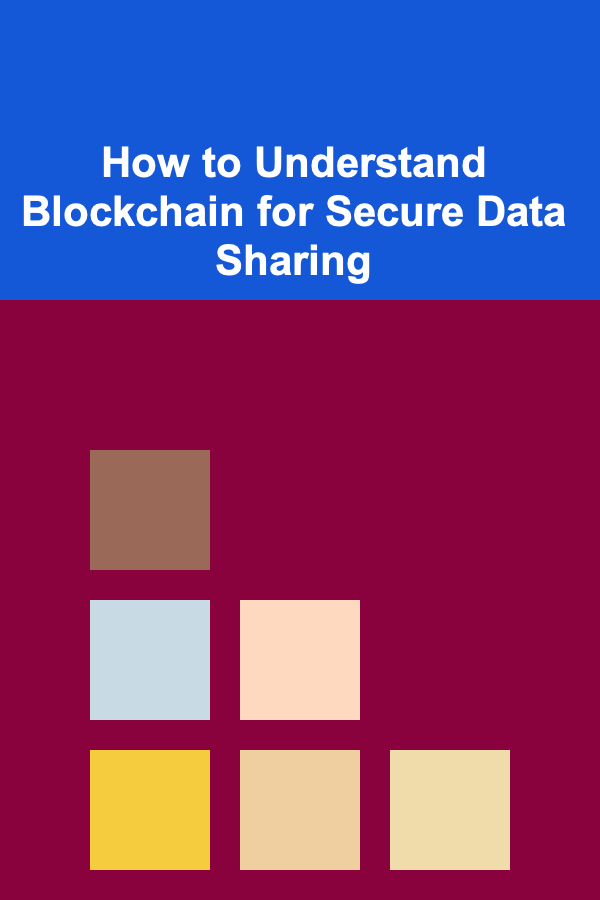
How to Understand Blockchain for Secure Data Sharing
ebook include PDF & Audio bundle (Micro Guide)
$12.99$7.99
Limited Time Offer! Order within the next:

In an era where digital transformation is sweeping across industries, securing data and ensuring its integrity have become paramount concerns. The rapid rise of blockchain technology, initially popularized by cryptocurrencies like Bitcoin, has brought about a transformative approach to data security and sharing. Understanding how blockchain works and how it can be used for secure data sharing is crucial for businesses, developers, and individuals seeking to navigate the modern digital landscape.
This article delves into the underlying principles of blockchain technology, its application in secure data sharing, and the mechanisms that make it a trustworthy and efficient solution for handling sensitive information.
What is Blockchain?
Blockchain is a decentralized, distributed ledger technology that records transactions across multiple computers in such a way that the registered transactions cannot be altered retroactively. This ensures the integrity of the data, as once a piece of information is added to the blockchain, it cannot be modified or deleted without altering every subsequent block, which requires consensus from the network participants.
At its core, blockchain is a chain of blocks, where each block contains a list of transactions. These blocks are linked together chronologically, forming a continuous chain of verified data. The decentralized nature of blockchain means that there is no central authority or single point of failure, which provides a high level of security and transparency.
The Principles of Blockchain Technology
Before exploring how blockchain facilitates secure data sharing, it is essential to understand the key principles that drive this technology:
2.1. Decentralization
One of the defining features of blockchain is its decentralization. Unlike traditional centralized systems, where a single entity has control over the database and can modify data at will, blockchain relies on a network of distributed nodes (computers) that work together to validate transactions. Each node maintains a copy of the blockchain, and no single node has complete control. This reduces the risk of manipulation or corruption of data, ensuring greater security and reliability.
2.2. Transparency
Blockchain is often described as a transparent system because all transactions are recorded on a public ledger that is accessible to all participants in the network. While the identity of participants may be pseudonymous, the transaction data is visible to all. This level of transparency ensures that every transaction can be verified by anyone, increasing accountability and trust among users.
2.3. Immutability
Once a transaction is added to the blockchain, it cannot be altered or deleted. This feature, known as immutability, is a critical element of blockchain's security. To change any piece of data within a block, it would require altering all subsequent blocks, which would be easily detectable by the network. This makes blockchain an ideal platform for secure data storage and sharing, as it guarantees the integrity of the information.
2.4. Consensus Mechanisms
Blockchain networks use various consensus mechanisms to validate transactions and add them to the blockchain. These mechanisms ensure that all participants in the network agree on the state of the blockchain and prevent fraudulent transactions. Some common consensus mechanisms include Proof of Work (PoW), Proof of Stake (PoS), and Practical Byzantine Fault Tolerance (PBFT).
These mechanisms ensure that the data recorded on the blockchain is accurate and trustworthy, as only validated transactions are allowed to be added to the chain.
Blockchain for Secure Data Sharing
With the growing volume of data being generated, particularly in sectors like healthcare, finance, and supply chain management, there is an increasing need for secure data sharing. Traditional methods of data sharing, such as centralized databases and cloud storage, often face challenges related to security, data breaches, and lack of transparency. Blockchain offers a revolutionary approach to these challenges by providing a decentralized, transparent, and immutable platform for sharing sensitive information.
3.1. Data Integrity and Security
One of the main advantages of blockchain in secure data sharing is its ability to ensure data integrity. As mentioned earlier, once data is recorded on the blockchain, it cannot be tampered with. This is especially important in industries like healthcare, where patient records must be accurate and unalterable. Blockchain guarantees that the data remains intact throughout its lifecycle, from collection to sharing and storage.
Moreover, blockchain employs cryptographic techniques, such as hashing and digital signatures, to secure the data. Each transaction is encrypted, and the cryptographic hash of the transaction is added to the block. This makes it virtually impossible for unauthorized parties to alter the data without being detected.
3.2. Privacy and Access Control
While blockchain offers transparency, it also allows for privacy and access control. In permissioned blockchains, where only authorized participants can access the network, blockchain can ensure that sensitive data is only shared with the right individuals. For instance, in the healthcare sector, patient data can be stored on the blockchain, and access can be restricted to only those healthcare providers who have the necessary permissions.
Furthermore, blockchain enables users to control their own data. Through the use of private keys and digital wallets, individuals can decide who has access to their data, providing a new level of personal data sovereignty. This is particularly relevant in industries where sensitive personal information is exchanged, such as finance, healthcare, and government services.
3.3. Smart Contracts for Automation
Blockchain technology also supports the use of smart contracts, which are self-executing contracts with the terms of the agreement directly written into code. Smart contracts automatically execute when predefined conditions are met, without the need for intermediaries. This makes them an excellent tool for automating secure data sharing processes.
For example, in a supply chain management system, smart contracts can automatically trigger payments or shipments when certain conditions are met, such as the delivery of goods or verification of inventory. Smart contracts ensure that the terms of the agreement are executed fairly and transparently, without the risk of human error or manipulation.
3.4. Reducing Fraud and Data Breaches
The decentralized and immutable nature of blockchain makes it an effective tool for reducing fraud and preventing data breaches. In traditional centralized systems, hackers can target a single point of failure to gain access to sensitive information. However, in a blockchain network, data is distributed across multiple nodes, making it much harder to compromise.
Additionally, since every transaction is recorded on the blockchain and can be traced back to its origin, any attempt to alter or falsify data would be immediately detectable. This provides a powerful deterrent against fraud and ensures that data shared on the blockchain remains trustworthy and secure.
Use Cases of Blockchain for Secure Data Sharing
4.1. Healthcare
In the healthcare industry, patient data is highly sensitive and must be protected from unauthorized access. Blockchain can provide a secure and transparent platform for sharing patient records among healthcare providers. By storing patient data on the blockchain, healthcare institutions can ensure that the data remains accurate and unalterable, while also enabling patients to control who has access to their information.
For example, a patient could grant permission to a specific doctor to access their medical records, while restricting access to others. Blockchain ensures that the data is only accessed by authorized parties, and any changes to the data are recorded on the blockchain, providing an audit trail of the information's history.
4.2. Supply Chain Management
Blockchain has the potential to revolutionize supply chain management by providing a transparent and secure method for tracking goods as they move through the supply chain. Each transaction, such as the shipment of goods or the transfer of ownership, is recorded on the blockchain, creating a verifiable and immutable record of the product's journey.
This helps to prevent fraud and counterfeit products, as every stage of the supply chain can be traced back to its origin. Blockchain also enables real-time updates and reduces the risk of data manipulation, ensuring that all parties involved in the supply chain have access to accurate and up-to-date information.
4.3. Financial Services
In the financial sector, blockchain can be used to securely share financial data, such as transaction records and account balances, between different institutions. Blockchain provides a tamper-proof ledger for financial transactions, ensuring that all parties involved in a transaction can verify its authenticity.
Blockchain can also improve the efficiency of cross-border payments by eliminating the need for intermediaries and reducing transaction costs. By using blockchain, financial institutions can process payments faster, more securely, and at a lower cost than traditional systems.
4.4. Government Services
Blockchain has the potential to improve the delivery of government services by enabling secure and transparent data sharing between different agencies and departments. For example, blockchain could be used to store and share records related to voting, land ownership, and identity verification, ensuring that the data is accurate, secure, and tamper-proof.
Moreover, blockchain can help improve transparency in government operations, as all transactions are recorded on the blockchain and can be publicly verified. This can reduce corruption and increase trust in government institutions.
Challenges and Limitations of Blockchain for Secure Data Sharing
Despite its numerous advantages, blockchain technology still faces several challenges when it comes to secure data sharing. Some of the key challenges include:
5.1. Scalability
One of the major challenges of blockchain is scalability. As the blockchain network grows, the number of transactions increases, which can lead to slower transaction times and higher costs. While solutions such as sharding and layer-2 protocols are being developed to address these issues, scalability remains a concern for large-scale applications of blockchain.
5.2. Regulatory Concerns
Blockchain is still a relatively new technology, and many regulatory bodies are struggling to keep up with its development. There is a lack of clear regulations regarding blockchain's use in certain industries, such as healthcare and finance, which can create uncertainty for businesses and individuals looking to adopt the technology.
5.3. Energy Consumption
Blockchain networks that use consensus mechanisms like Proof of Work can be energy-intensive, leading to concerns about their environmental impact. As blockchain technology evolves, more energy-efficient consensus mechanisms, such as Proof of Stake, are being developed to address this issue.
Conclusion
Blockchain technology offers a groundbreaking approach to secure data sharing. Its decentralized, transparent, and immutable nature provides a high level of security and integrity for sensitive data. By leveraging blockchain's capabilities, industries such as healthcare, finance, and supply chain management can ensure that their data is secure, accurate, and accessible only to authorized parties.
While blockchain presents many opportunities for secure data sharing, it also faces challenges related to scalability, regulation, and energy consumption. As the technology continues to evolve, these challenges are likely to be addressed, making blockchain an increasingly powerful tool for ensuring the security and integrity of data in the digital age.

How to Create a Functional Entryway in Your Apartment
Read More
How to Create a Unique Save-the-Date and Invitation Strategy
Read More
How to Organize Your Car for Road Trip Readiness
Read More
How to Set Up an Investment Portfolio That Matches Your Risk Tolerance
Read More
How to Store and Organize Kitchen Utensils in Small Kitchens
Read More
The Ultimate Guide to Comparing Internet Service Providers for Better Deals
Read MoreOther Products

How to Create a Functional Entryway in Your Apartment
Read More
How to Create a Unique Save-the-Date and Invitation Strategy
Read More
How to Organize Your Car for Road Trip Readiness
Read More
How to Set Up an Investment Portfolio That Matches Your Risk Tolerance
Read More
How to Store and Organize Kitchen Utensils in Small Kitchens
Read More